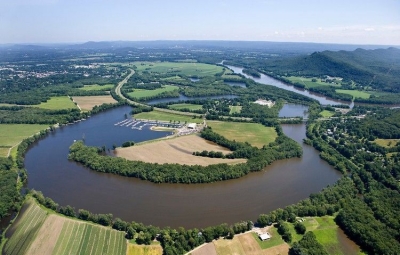
|
When a river flows through low-lying plains, it slows down, carving out a meandering path with many U-shaped curves. Over time, some of these curves become cut off from the main flow of the river by the build-up of silt deposits, and form oxbow lakes. These distinctive, curved water bodies are close to a river but separate from it. |
An oxbow lake starts out as a curve, or meander, in a river. A lake forms as the river finds a different, shorter, course. The meander becomes an oxbow lake along the side of the river.
Oxbow lakes usually form in flat, low-lying plains close to where the river empties into another body of water. On these plains, rivers often have wide meanders.
Meanders that form oxbow lakes have two sets of curves: one curving away from the straight path of the river and one curving back. The corners of the curves closest to each other are called concave banks. The concave banks erode over time. The force of the rivers flowing water wears away the land on the meanders concave banks.
The banks opposite the concave banks are called convex banks. The opposite of erosion happens here. Silt and sediment build up on convex banks. This build-up is called deposition.
Erosion and deposition eventually cause a new channel to be cut through the small piece of land at the narrow end of the meander. The river makes a shortcut. Oxbow lakes are the remains of the bend in the river.
Oxbow lakes are stillwater lakes. This means that water does not flow into or out of them. There is no stream or spring feeding the lake, and it doesnt have a natural outlet. Oxbow lakes often become swamps or bogs, and they often dry up as their water evaporates.
Credit: National Geographic Society
Picture Credit : Google




